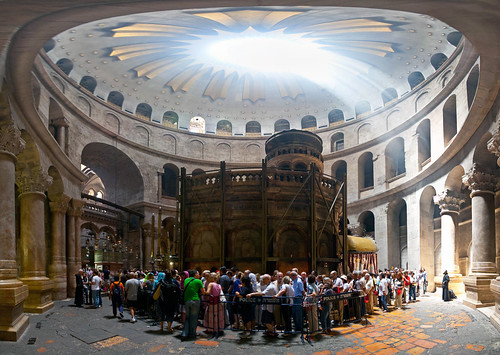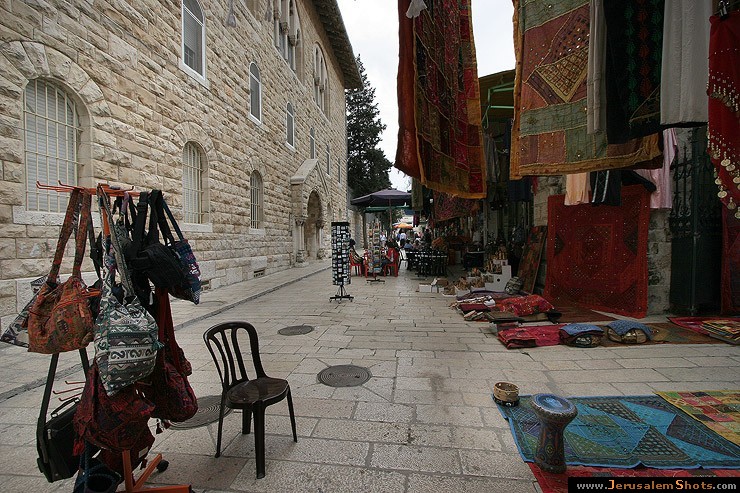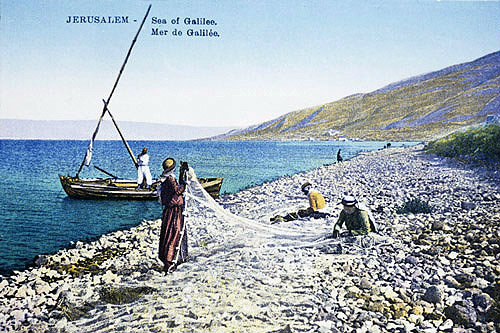3. Was this first appearance to Peter at the Sea of Galilee?
Tiberias, last century
This is the only appearance to Peter narrated, and it's a very important one. The Gospel of Peter is apocryphal and narrates it as the first appearance. Some Protestant scholars, especially starting with German ones in the 19th century, propose this as the "original" account of that first appearance.
One obstacle to the theory at first glance is that Luke says that the 11 apostles were gathered and saw Jesus in Jerusalem that night, which implies Peter must have been there (the 12 minus Judas), not in Galilee. However, we know that "the eleven" and "the twelve" only refers to the collective and not to a precise count, because Thomas was not there either that first night, (as per John 20) and he was one of the 11.
The real main obstacle this theory faces is that it does strongly conflict with the canonical gospel account for the reasons in the last post.
For example, a reason in favor of the third version is that when John 20:10 says that Peter returned to his own, it could mean that Peter went home to Galilee. This would explain why in John 21 Peter and Thomas were fishing even though in Luke's account Jesus told those gathered on Day one at the house in Jerusalem to wait in Jerusalem. Of course, it is too much of a stretch to say that Peter arrived home on Day 1 of the resurrection if that morning he was at the tomb as per John and Luke. So to except this third theory, you are forced to think that the account of Peter being at the tomb is an invention.
Another contradiction is that in Luke 24, before Jesus appeared to them collectively, the apostles gathered tell the Emmaus travelers with joy that Jesus was risen and appeared to Peter, which they wouldn't know that same day if Peter was all the way in Galilee. So again you are forced to reject what Luke 24 says about this here, as if it's made up.
Indeed, this announcement by the apostles that they knew Jesus appeared to Peter does have another conflict- in Mark 16 it says that the apostles did not believe in Jesus' resurrection at that moment, until later when Jesus appeared to them. So it's true that based on Mark 16 you can argue that the announcement of the appearance to Peter in Luke 24 is invented, but to make that argument you are no longer strictly going by Luke's account.
You are really stuck arguing that Luke or his source changed the story, so that Peter would be in Jerusalem that day. one way to do this is to look at Mark 16, where the angel tells the women: "tell his disciples
and Peter that he goeth before you
into Galilee: there shall ye see him, as he said unto you."
Matthew basically says the same thing, predicting an appearance in Galilee. And Mark 16:1-8 (considered the "original" ending of Mark) and Matthew do not mention any appearances in Jerusalem, so based on Mark and Matthew alone you would imagine the appearances were just in Galilee, especially the one to Peter, as he is mentioned there.
Luke apparently edits the reference to Galilee's appearances in the words of the angel, making him say:
" remember how he spake unto you when he was yet
in Galilee, Saying, The Son of man must... be crucified, and the third day rise again."
Then, in Luke 24, Jesus shows up on Day 1 to the apostles and tells them to stay in Jerusalem until the Pentecost (Day 50). So if you go by Luke alone, you would imagine that there were no appearances in Galilee. Luke has apparently edited them out.
If we were not talking about "sacred scripture" but about some secular accounts of some events that took place 2000 years ago, I think people would be more open to the Germans' proposal that the gospel of Luke and John, in which Peter is at the tomb on Day 1 and thus not in Galilee, effectively rewrote the story in this way and ruled out a preceding appearance by Jesus to Peter in Galilee by the sea.




